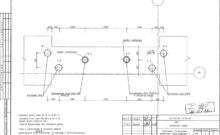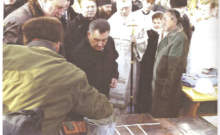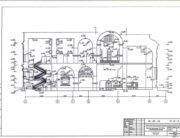The first known engineering and geological surveys date back to 1787. For a long time, large cracks appeared in the designs of the Assumption Cathedral and the question arose of repairing the cathedral. The Assumption Cathedral was investigated by the provincial architect Lresant and the architect Buzzi. According to these experts, the deformations in the temple led mainly to uneven precipitations of multi-temporal extensions to the cathedral through wetting of the foundations, which did not have a reliable blind area. The architects suggested closing the cracks with the position of iron, brick or stone wedges with lime, alabaster, looking for voids, filling it up hard with earth, filling the whole slope with clay with a ramp and then laying it on the previously solid stone pavement. It is not known whether the recommendations regarding the device of the clay castle and the stone pavement along the entire perimeter of the building were fully implemented. It has been documented only that the paving of the boulderiness of a wild stone on the eve of the Assumption Cathedral in 1789 fell into disrepair in 1783. It was re-translated.
The existing engineering sector, namely: the drain sewage system, drainage system, heating channel networks and other auxiliary networks were in a dilapidated state, which made the general engineering and technical condition of the territory difficult, and led to a deterioration of the groundwater regime, deformations of the building structures located near the cathedral.
Since the main reason for the increased soil moisture was water leakage from aquifer communications, it was necessary to choose the safest means of laying utility networks.
Loess soils with a depth of 8–12 meters under the foundations of the Assumption Cathedral created the threat of uneven deformations when wet, and therefore it was necessary to create an almost non-formative basis of the cathedral. As A. V. Sitkarova writes, the presence of forest subsiding grounds at the foundation of the Assumption Cathedral forces specialists to give priority attention to the development of measures to prevent soil moisture in the construction site of the temple, that is, the development of precisely those processes that cause deformation of structures.
In 1894 additional heating was conducted on the choir. At the same time, proposals were made to the Theological Cathedral to study the experience of installing heating and ventilation systems in churches in other cities. In October 1900 p. N.K. Berg has developed a additional project on the device of heating the chapel to the Archids Stephen of the Assumption Cathedral. The project was implemented in 1901 p., And already in the next 1902 p. NK Berg developed a project for the installation of exhaust and additional steam lines. In 1904, the old steam boiler was replaced, the Annunciation Church was also connected to the new boiler. Thus, arranged in 1885. The heating and ventilation system of the cathedral was expanded and improved over time.
With the explosion of the temple in 1941. Brick galleries of the heating system were partially destroyed and covered. In the process of digging up the ruins of the ruins of the Assumption Cathedral under the leadership of M. V. Kholostenko in the postwar period, they were surveyed within the limits of the Old Russian cell of the temple.
Studies have found that the main gallery of the heating system, which crosses the central part of the temple from south to north and from the south, connected the Assumption Cathedral with the basements of the Refectory Church and the chamber where the steam boiler was installed.
The total length of the section of the main gallery, which was traced in 1962-1963. It was about 51.5 m. On the north side, in the area of archdeacon Stephen outside the Old Russian cell of the temple of the 11th century. the gallery was destroyed.
The main gallery was a vaulted adit in the section of 85×140 cm. In it
On the east side of the main gallery of the heating system of the cathedral of the XIX century. branches were connected with the underground under the altar part of the temple, brick arches on brick columns 43×43 cm. height 35 cm, arranged through 90 cm.
Underground galleries made underground channels of heating, the hatches of which (size 27×54 cm) reached the level of the temple floor and were covered with metal bars.
In 1982-1986 During the carrying out architectural and archaeological research brick underground channels of the heating system of the cathedral of the XIX century. were uncovered in four pits, including near the southwestern pillar of the domed space, at the locations of the stairs leading to the second tier from the south and north from the western entrance to the cathedral, as well as another section of the heating system was opened in the northern part of the narthex.
The underground brick gallery, held in the area of the northern stairs, was in an unsatisfactory condition, its arches collapsed. The gallery was directed to the west with a smooth turn to the north.
The plot of the gallery at the location of the southern steps was in a satisfactory condition.
Work on the study of the channels of the heating system was continued in 1997, when cleared and explored the section of galleries within the ancient hearth of the temple 100 m long.
Later, at the beginning of the work of the zero cycle, sections of underground galleries in the area of Western risalits and in the aisle of Archdeacon Stephen were discovered and surveyed.
The above-mentioned brick galleries of the former heating system of the cathedral were used in the development of modern heating and ventilation networks of the cathedral.



















